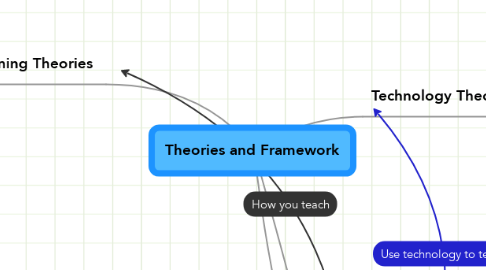
1. Learning Theories
1.1. Connectivism
1.1.1. Theorists
1.1.1.1. George Siemens
1.1.1.2. Stephen Dawnes
1.1.2. Newest Theory
1.1.2.1. Developed in 2006
1.1.3. Based on the idea learning is done by creating a network
1.1.4. Having information when you need/want it
1.1.4.1. Available when ever you want
1.1.5. Technology based
1.1.6. Interpreting different ideas on the same topic to create your own point of view
1.2. Constructivism
1.2.1. Mind is a network that never stops growing
1.2.2. Knowledges is based on your interactions with the environment around you
1.2.3. Teacher aided
1.2.4. Group learning environment
1.2.4.1. Problem solving
1.2.5. Different types of learning
1.2.5.1. Discovery
1.2.5.2. Case- based
1.2.5.3. Active
1.2.5.4. Collaborative
1.2.6. Example: Group projects
1.3. Cognitivism
1.3.1. Theorists
1.3.1.1. Piaget
1.3.1.2. Gagne
1.3.1.3. Vygotsky
1.3.1.4. Bruner
1.3.2. Mind starts with zero knowledge
1.3.3. Practice for retention
1.3.4. Base learning previous knowledge or memories
1.3.4.1. Previous knowledge or memories are the building blocjs for more learning
1.3.5. Works on organization of thoughts and ideas
1.3.5.1. Mindmaping
1.3.6. Example: Brainstorming ideas for an english paper and organizing your ideas into intro, body and conclusion
1.4. Behaviourism
1.4.1. Theorists
1.4.1.1. Pavlov
1.4.1.2. Thorndike
1.4.1.3. Watson
1.4.1.4. Skinner
1.4.2. Based on the idea that practice makes perfect (repetition is key)
1.4.3. Shaping and molding the brain
1.4.4. Punishment or a consequence for doing something wrong
1.4.5. Teacher-directed
1.4.5.1. Lecture Based
1.4.6. Example: Rewriting all the words you got wrong on your spelling test at least 5 times
2. Philosophy of Technology
2.1. Technology shows a teachers views on technology in the classroom
2.2. Similar to teaching philosophy
2.3. Each teacher has their own take on it.
2.4. There is no right or wrong answer
2.5. Addresses how to use technology efficiently in a classroom setting
3. Technology Theories
3.1. SCOT
3.1.1. Social construction of technology
3.1.2. The success of technology is based on the social environment
3.1.3. Technology is affected by humans
3.1.4. Better technology does not always win
3.1.5. Example: Beta vs. VHS or BluRay vs. HD DVDs
3.2. Media Ecology
3.2.1. Study of media as environments
3.2.2. Media is not an object or an organization
3.2.3. Media
3.2.3.1. Art
3.2.3.2. Technology
3.2.3.3. Study environments as media
3.2.3.4. Symbolism
3.2.3.5. Books
3.2.3.6. Internet
3.2.4. Form of communication
3.2.5. Media has a strong effect on the way people view the world
3.2.6. People affected by technology
4. TPACK
4.1. Based on 3 areas of knowledge
4.1.1. Technology
4.1.2. Pedagogy
4.1.3. Content
4.2. Uses a Venn Diagram to explain the differences and similarities of the areas
4.3. Need all a balance of all three to be a great teacher
4.3.1. Can get by with less but won't be as great (depends on the student and their environment)
